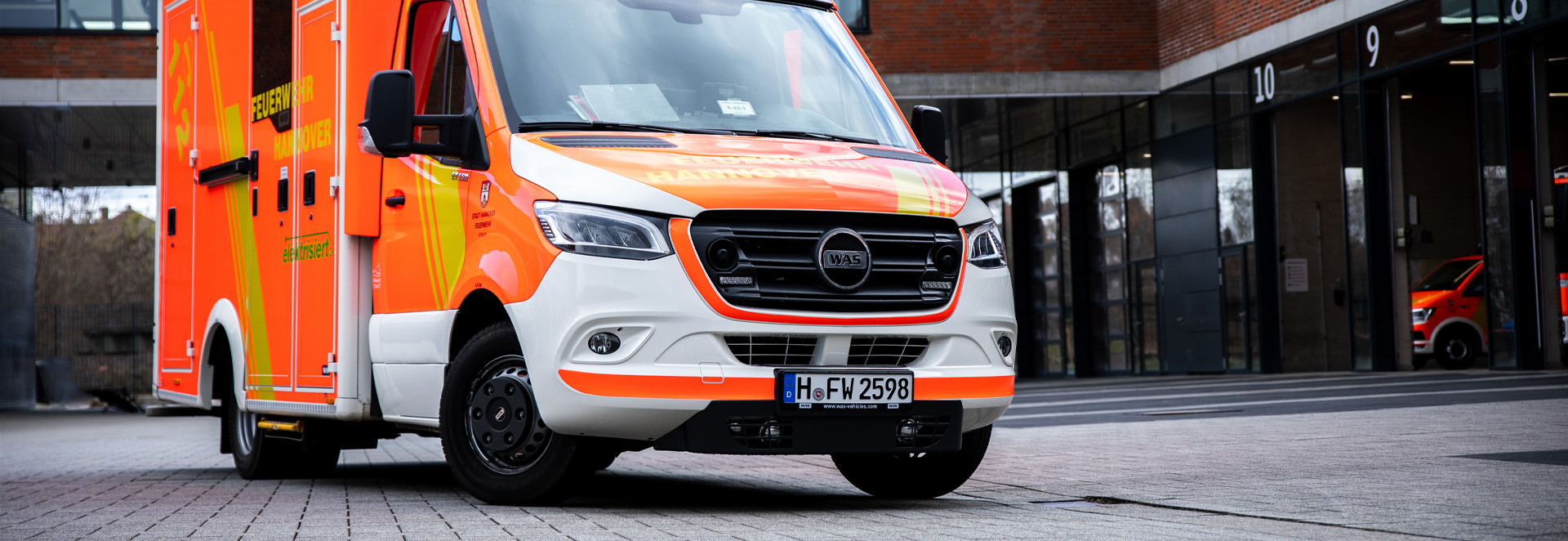


Rainer Kunze from the Hanover City Fire Brigade welcomes us on a Monday in March. We are led by him through long corridors and quite a few doorways in Fire and Rescue Station 1, which was completed only two years ago. The station houses the regional control centre as well as all units of the rescue service, a fire enginge, special vehicles, plus the administration and workshops of the Hanover Fire Brigade. Kunze‘s function is described on his business card as follows: 'Department of Fire Services of the City of Hanover, Head of Vehicle and Equipment Technology, Personal Protective Equipment (OE 37.31)'. After providing us with coffee, he lets us know that the Hanover Fire Brigade is much more than a fire brigade with full-time and honorary staff in a special constellation. The special feature lies in the organisation of the task areas of fire protection, disaster control, civil protection and rescue service. Kunze speaks of the concept of an 'overall package' that completely covers the interlocking tasks in the event of an operation, or at least temporarily until
special units arrive.
Redundancies for civil protection.
During the guided tour of the building, we learn that all functions are at least doubly secured. If the water fails, the cistern takes over. If the electricity fails, the generators take over. If the building has to be evacuated of people, the entire range of functions of the regional control centre is available at another fire station in the north of the city. And so it is with all the functions. A security system with sophisticated backups to protect the approximately 1.2 million people, businesses and also the airport in Hanover Region.
Rescue and fire services organised holistically.
In the Hanover Fire Brigade, the rescue service and the fire brigade are thought of as a joint unit with different functions, right down to the smallest detail. Although both units work alone in their functional core tasks during regular operations, highly qualified and experienced emergency paramedics also go out with the fire engines of the Hanover Fire Brigade in the event of special incidents involving injured or ill persons. This is why about 450 of the 850 full-time firefighters are active paramedics, Kunze outlines the team strength of the entire unit. They work together according to clearly defined rules and procedures.
Moreover, not only the functions are coordinated down to the smallest detail. The equipment of all units was also decided upon and purchased after intensive preliminary planning work. Kunze takes us into the new equipment warehouse and explains how specially designed it is, using a protective jacket as an example. “Things like this are developed together with our users. This way we make sure that we get what we need in the field to be able to work as quickly and accurately as possible. Human lives and the lives of the emergency services are at stake here and sometimes seconds are crucial. When it comes to procurement, this of course means that we approached manufacturers for protective clothing, for example, and described to them in advance what we had in mind. In the end, for example, we get a jacket that is tailored exactly to our ideas and not an off-the-peg one, because there are no off-the-peg inserts either. Before we order, we test intensively for functionality and durability in use. This is how we proceed with all purchases, including vehicle equipment. The suppliers have to learn how to deal with our demands”, Kunze tells us and looks over at Christoph Stegemann (WAS), with whom he coordinated the equipment of the new WAS E-ambulance, with a meaningful smile.
Equipment and frequency of operations of the Hanover Fire Brigade
| Vehicle fleet | |
| Professional fire brigade | 196 |
| Rescue service | 41 |
| Volunteer fire brigade | 99 |
| 336 | |
| Employees | |
| Professional fire brigade | 879 |
| Volunteer fire brigade | 740 |
| 1.619 | |
| Operations Hanover Fire Brigade | |
| Rescue service | 61.245 |
| Fire brigade (fire protection and assistance) | 7.979* |
| 69.224 | |
| Operations regional control centre | |
| Rescue service | 170.623 |
| Fire brigade (fire protection and assistance) | 16.770 |
| Ambulance transport | 68.442 |
| Intensive care transport (Central coordination centre Lower Saxony) | 5.698 |
| 261.53 |
*Figures 2021
Firefighters with emergency paramedic training.
Another example for him is the equipment of the rescue and fire engines. They are all equipped exactly the same, including the equipment needed for rescue operations. They are fitted identically, so that there is no need for equipment search time during operations. Everyone knows where everything is. When asked, Kunze confirms that the fire brigade‘s emergency vehicles also have a mobile emergency kit for medical care, analogous to the equipment in the ambulances. “Every rescue fire engine is equipped with at least four firefighters who have received emergency paramedic training. This helps to alleviate pressure on the rescue service, as they are able to provide medical treatment to injured individuals on site immediateley upon the fire brigade’s arrival”, Kunze explains. For example, in the event of a mass casualty incident (MANV), 12 firefighters with training in emergency medical services are on standby to provide initial emergency medical care in special emergency situations. Additional material can be quickly made available at special scenes of operation by means of trolleys of three rescue service vehicles (GW-Rett). A command vehicle with the organisational head of rescue services (OrgL), a specially trained emergency command service, can also be on its way to the scene of an emergency within 60 seconds. Here, together with the chief emergency physician (LNA), he forms the local emergency service command (ÖEL) and coordinates all emergency service measures on site. “Certainly not many municipal fire brigades in Germany have set up and organised themselves in this way”, Kunze concludes. The latest acquisition, the WAS 500 E-ambulance, is the prelude to the next challenge that lies ahead for Rainer Kunze and the Hanover Fire Brigade: The initiation of the traffic turnaround to protect the climate. In the state capital, there is a council resolution to accelerate the traffic turnaround in its own vehicle fleet. As a pioneer, the fire brigade is now sending Europe‘s first series-production model of a fully electric ambulance in the 5.5 t class onto the streets of the state capital Hanover.






No Comments